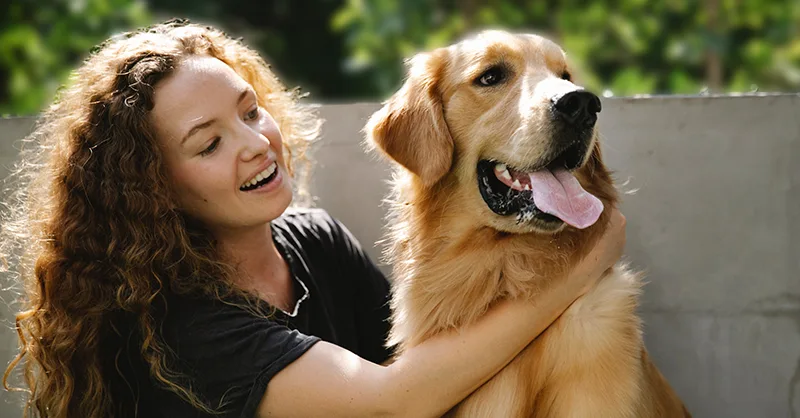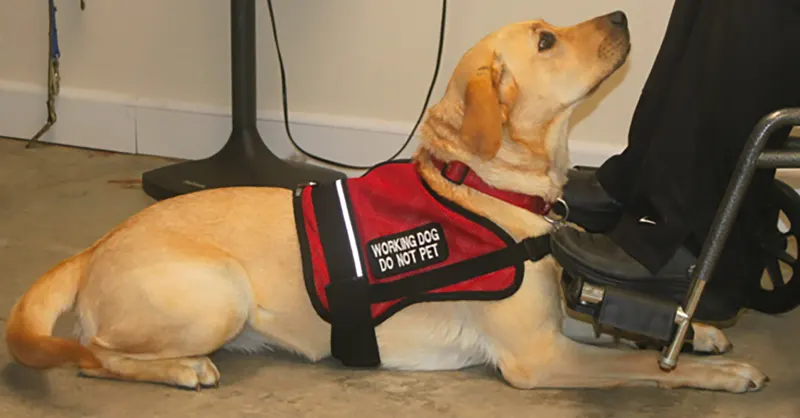Archive for the ‘Service Dog Tips’ Category
If you suspect someone is lying about having a service dog, there are ways to tell whether the person is being truthful or not without violating the Americans with Disabilities Act. You can separate real service dogs from fake ones by knowing a few rules, observing the dog’s behavior, and questioning the owner.
In this guide, our ADA experts will teach you how to spot a fake service dog while avoiding trouble for infringing on service dog owner rights.
Behaviors that Indicate a False Service Dog Handler Actions that Indicate a False Service Dog Common Mistakes in Identifying Fake Service Dogs Emotional Support Animals versus Service Dogs Penalties for Pretending to Have a Service Dog Behaviors that Indicate a False Service DogA service dog needs special training to perform a task related to the handler’s disability. Service dogs also have to be trained to behave in public settings (sometimes even passing a public access test). A venue can request that a service dog leave the premises if it is acting aggressively or causing property damage.
Here are some behaviors to look for if you think a service dog is not real:
1. Lack of Focus and AttentivenessA legitimate service dog should maintain constant awareness of their handler and respond quickly to commands or changes in the handler’s condition. Non-service dogs may appear distracted, unfocused, or overly interested in their surroundings rather than their handler. Keep in mind, though, that service dogs, like normal dogs, are sometimes set free for playtime.
2. Poor Leash MannersService dogs should be able to calmly walk beside their handler, typically on a loose leash without pulling. If the dog is pulling on the leash, zigzagging, or struggling to maintain a consistent walking pace with their handler, it may not be properly trained.
3. Inappropriate VocalizationsMost service dogs remain quiet unless performing a specific task that requires barking (like alerting a blind individual to danger). If the dog frequently barks, growls, whines, or makes other noises without any apparent purpose, that should raise your suspicions.
4. Inappropriate Behavior in Public SpacesService dogs are trained to be calm and composed in various environments, including crowded or noisy places. Non-service dogs might show signs of stress, aggression, or fear in public settings, such as growling, excessive panting, or attempting to hide.
5. Poor Impulse ControlService dogs can resist temptations like food on the ground, other animals, or interesting smells when they are on duty. If you see that the handler cannot control their dog from lunging for food, becoming overly excited by scents, or trying to interact with other animals, it might not be a service dog.
6. Lack of Basic ObedienceA minimum requirement for service dogs is the ability to respond promptly to basic commands like sit, stay, and come. If you see a dog that ignores basic commands, it may not be a service dog.
7. Overprotective or Aggressive BehaviorService dogs are trained for public access. That means remaining neutral towards other people and animals unless performing a specific protective task. Service dogs should never display overprotective behaviors, growl at strangers, or show aggression toward other animals or people.
Note that, in all these instances, small misbehaviors are not enough to say if someone’s service dog is fake. For example, pulling slightly at the leash, getting excited, or becoming slightly distracted is normal, even for a service dog. After all, service dogs are still dogs, and, like their human companions, they are not 100% perfect.
You should try to observe the service dog’s complete behavior and interactions with the owner. Under ADA guidelines, for a venue to dismiss a service dog, the dog has to pose a threat to safety or health or be out of control.
Share this image on your site (copy code below): <div style="clear:both"><a href="https://www.servicedogcertifications.org/catching-fake-service-dogs/" target="_blank"><img decoding="async" style="max-width:100%;margin:0 0 10px;" src="https://www.servicedogcertifications.org/wp-content/uploads/2024/07/how-to-spot-fake-service-dogs.jpg" title="How To Spot Fake Service Dogs" alt="Behaviors that might indicate a false service dog" border="0" data-src="" /></a></div> Copy
Handler Actions that Indicate a False Service DogAs a venue staff member, a landlord, or an airline agent, you’re allowed to ask two questions under the ADA to verify if someone has a service dog: 1. Is the dog a service dog required for a disability? and 2. What work or task has the dog been trained to perform?
These are the ONLY questions that can be asked to confirm someone has a service dog. If they can’t answer both questions, you have the right not to let the dog enter. Keep in mind that you can’t ask specific questions about a person’s disability or ask the dog to demonstrate its task.
Even if the handler shows you a service dog ID card, certificate, tag, or vest, you can still rely on the two questions. Service dog owners use these items to signal that their dog is a service animal, but they don’t exempt them from having to answer the ADA verification questions.
Some people wonder why they can’t ask more specific questions. Others have proposed that service dog ID cards and registrations become mandatory. The reason is that service dog laws have to respect the privacy of service dog owners and should not burden them with obstacles.
The vast majority of dog owners act ethically and do not pass their dogs off as service dogs. It would be unjust to punish service dog handlers by subjecting them to probing questions or documentation requirements just because of a few bad apples.
Common Mistakes in Identifying Fake Service DogsThese are NOT reasons to assume a service dog is fake:
When the dog is small: Not all service dogs are Golden Retrievers, Labradors, or German Shepherds! Service dogs come in all shapes and sizes. Sometimes, smaller service dogs are better suited to the owner’s lifestyle. For example, a lap dog can be perfect for someone who needs a psychiatric service dog but lives in a small apartment. When the person doesn’t have an obvious disability: Never assume a service dog is fake because the handler doesn’t “look” disabled. Many serious disabilities are not visible, especially psychiatric conditions. When the service dog has no vest, ID card, or tags: Most service dogs wear vests, tags, and ID cards so others can easily spot them. But they are not mandatory! You should never assume a service dog is fake just because they lack these items. When there is more than one dog: Some people think owners with two service dogs are faking it, but the ADA recognizes people who need more than one dog. It is not uncommon for someone to have one dog trained for one need and another trained for a separate health issue. When the dog is a mixed breed: Service dogs are not just pure breeds. Shelter and rescue dogs also serve as capable service dogs. Under the ADA, there are no breed limitations when it comes to service dogs. Despite the dog’s apperance, a service dog can come in shapes and sizes that might look suspicious to others. Emotional Support Dogs Pretending to be Service DogsIt’s not entirely accurate to call emotional support animals “fake service dogs”. ESAs are also legally recognized assistance animals that help people with mental health disabilities. There is certainly nothing fake about their importance to people with mental illness.
However, if a person comes into a store or other venue like an airport claiming they are not subject to no-pet rules because they have an emotional support dog — they are wrong. ESAs only have housing rights. Emotional support animals are not the same as service dogs and do not have the same rights under the ADA.
Many people make the honest mistake of not realizing the legal differences between emotional support animals and service dogs. If someone tries to bring their ESA into a no-pets zone, you can gently inform them that while your establishment gladly welcomes service dogs, emotional support animals are not the same thing.
Penalties for Pretending to Have a Service DogMany states have taken the initiative to create laws that address service dog fraud. These laws should further discourage people from pretending that their pet is a service dog. Here are some examples of state laws and their penalties:
California Penal Code 365.7: Knowingly and fraudulently representing a dog as a service dog is classified as a misdemeanor Florida Statute 413.08(9): Misrepresenting an animal as a service animal is a second-degree misdemeanor Texas Human Resources Code, Title 8, Chapter 121.006: Intentionally or knowingly representing that an animal is a service animal when the animal is not specially trained or equipped to help a person with a disability is a misdemeanor. Washington RCW 49.60.214: Misrepresenting an animal as a service animal is a civil infraction. Balancing Awareness with RespectWhile it’s important to be aware of potential fake service dogs, it’s equally important to approach the situation with sensitivity and respect. Remember:
Not all disabilities are visible. Service dogs can be trained for a wide variety of tasks and disabilities. The ADA limits the questions that can be asked about a service animal. Focus on the dog’s behavior rather than making assumptions about the handler.By understanding the behavioral indicators and legal rules surrounding service dogs we can better support those who genuinely need these amazing assistants while discouraging fraudulent misrepresentation.
The cost of training a dog to be a service dog varies by region. We’ll help you choose the right service by comparing the prices of different training options and giving you an estimate based on your state or region. Keep in mind that sometimes the cheapest option might be right across a state border for things like doggy camp (aka “board and train”). Other times, you might find a good out-of-state dog trainer online who will help you train your dog at home, so the best option isn’t necessarily the one closest to home.
Training costs vary by how hands-on the professionals areWhen looking for training programs or classes, keep in mind that not all trainers offer the same services. Generally, dog trainers fall into three types:
Professional trainers who teach self-training (the handler trains the dog with the help of the professional trainer) Professional trainers who train the dog themselves (whether through private sessions, group sessions, or “board and train” programs) Professional trainers who train dogs and sell already trained dogs (without offering training services for the dog you may already have)In this article, you’ll find an overview of the first two types of trainers and their costs. The first option, self-training, is more affordable, while the second option, professional training, is more expensive. The third option (paying for an already-trained dog) usually starts at $25,000 but can go higher. However, we will only look at training services, not trained dogs for sale. The hourly rates below are calculated on the basis of 48 hours per training program. Self-training costs are calculated by estimating the price of online trainer involvement or an online self-training interactive guide.
Region Self-training Price ($/hr) Board & Train Price ($/hr) Pacific Northwest (OR, WA) $40–$100 $165–$815 California (CA) $75–$200 $175–$415 Mountain West (AZ, CO, ID, MT, NM, NV, UT) $50–$300 $180–$560 Great Plains (ND, SD, NE, KS, MY, MN, IA, MO, WY) $40–$120 $200–$275 Midwest (IL, IN, OH, WI, MI) $40–$100 $180–$600 Texas (TX) $60–$150 $165–$250 Continental South (AL, AR, KY, LA, MS, OK, TN, WV) $40–$100 $400–$500 Atlantic South (FL, GA, NC, SC) $50–$100 $180–$520 Mid-Atlantic (DC, DE, MD, PA, VA) $50–$120 $315–$625 New York (NY) $75–$150 $520–$700 New England (CT, MA, ME, NH, RI, VT) $60–$105 $200–$520 Hawai’i (HI) $80–$150 $200–$600 Alaska (AK) $70–$120 $530–$725To find dog trainers near you, check out this page.
Prices vary by level of your participation and professional involvementOverall, self-training a dog with the help of a professional has lower-end prices from $40 to $100 an hour because you are hands-on and actively involved throughout the process. If you want to be less involved in the training, you can expect higher-end prices from $200 to $600 an hour. One of the most common hands-off training types is board-and-train programs, where you deliver your dog to the trainer for on-premises training at the facility. The higher-end prices are similar for private and/or group sessions that don’t require your involvement.
The amount of hands-on training by the handler depends on the chosen training program, but generally, more involvement means lower costs. Dog training can take weeks or monthsWe used 48 hours of training as the baseline to estimate hourly rates to make them comparable, but each trainer and each program have varying durations. This number is based on an average of select programs from reliable trainers across the country.
The duration of training depends not only on the individual trainer but also on your dog’s age. The younger the dog, the quicker the training will be, and the more trainers will be willing to accept the dog into their training program. Additionally, large dogs are considered easier to train than small dogs, and certain trainers only work with specific breeds. However, all breeds of dogs are trainable, and the notion that “only certain breeds are good for service dogs” is a myth.
Some dog trainers offer a basic package that involves around 4 sessions of basic training and 2–4 sessions of more advanced training, with the following sessions priced on a per-session basis (anywhere from $50 to $100/hour). These sessions are spread over the course of weeks or months, taking anywhere between 9 months and 2 years, depending on the skill level the dog will get and how old the dog is when starting the training.
Example 1: Cascade Service Dogs in Washington (state) estimate that self-training your dog takes around 9–12 months. Programs that only last a few weeks usually only provide basic training, which doesn’t guarantee that the dog will pass a public access test. Read more on the public access test here.
Example 2: Faithfully K9 in Colorado charges a flat $85/session or free for Active Duty and Veterans, but as a nonprofit, they acknowledge that this covers only half the cost of the training and that the total cost (to them) comes out to $10,000 per dog. Other trainers specify a total duration for the whole training (for example, 8 weeks) or recommend a certain number of training hours for you and your dog (usually several hundred hours if done entirely at home).
Example 3: Take Certified Canine Services in New York — they start with a 6-week basic service dog program before moving on to task training, which is more individualized and tailored to your specific dog.
Many trainers don’t list their prices publicly (and prices vary by dog)Since every dog is different, many experienced trainers have different prices based on your dog’s age, size, and breed. Most dog trainers offer different types of training, including non-service types like obedience training and non-psychiatric service training. For this reason, they don’t write a blanket price for all training on their website and prefer that you reach out to them so they can understand more about the tasks you would need your service dog to perform and what kind of dog you have. Don’t hesitate to reach out and ask if you don’t find the information you need!
Yes, dogs can definitely enjoy apples, including the skin! Apples are a fantastic snack for dogs because they’re packed with nutrients like fiber for healthy digestion, vitamins A and C, antioxidants that help fight off cell damage, and calcium for strong bones and teeth.
When you’re giving your dog an apple, just make sure to cut it into small, manageable pieces and remove the core and seeds. The seeds contain a tiny bit of cyanide, which is a bit scary to hear, but it’s actually found in very small, harmless amounts in many fruits, including peaches.
You might be wondering about the skin—yes, it’s safe and healthy for dogs, too! Apple skins are rich in fiber and additional nutrients, which are beneficial for your dog. If the apple is not organic, just ensure it is washed well to remove any pesticides or chemicals from the surface.
However, it’s important to serve apples in moderation because they do contain sugar. This could be a concern for dogs with conditions like diabetes or those sensitive to sugar intake. Sugar content varies slightly among apple types, but the difference isn’t huge—for instance, Granny Smith apples have about 9.59 grams of sugar each, whereas Gala apples contain around 10.4 grams.
When feeding your dog apples, adjust the amount according to their size and age. Typically, one or two apple slices a day make a great treat. If you’re keeping track of their diet, treats should only make up about 10% of their total daily calories. Always consult your vet if your dog has special dietary needs.
When feeding apples to your dog, make sure to prepare them properly and adjust the amount according to your dog’s needs.Organic applesauce can be a safe treat, too, but check for added sugars. Dried apples are a fun, crunchy alternative, but avoid apple juice, as it often includes added sugars and other ingredients not suitable for dogs.
In conclusion, dogs can certainly eat apples, skin, and all, and they’re likely to love this healthy, crunchy treat! Just remember to serve them in moderation and safely prepare them by removing the core and seeds.







